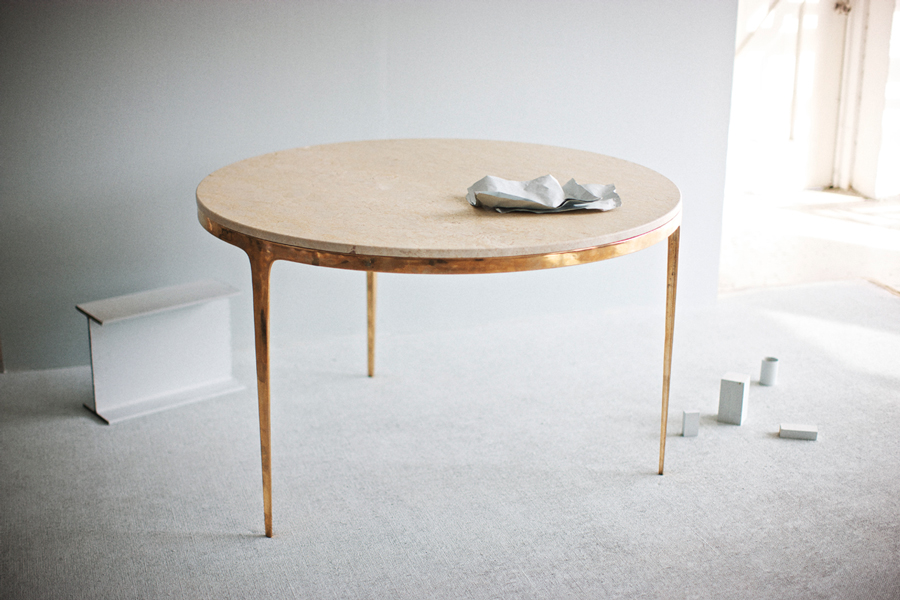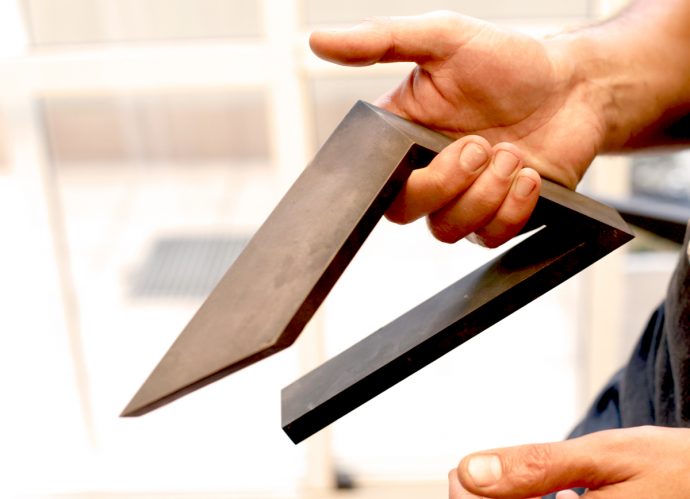Inventing designs for lost time: Daniel Barbera

If you had the questionable fortune to witness the reality TV series Design for Life, you might assume that notoriety beats functionality in the design game – and that designers aspire to be demi-gods. Yet, in a secret Melbourne workshop, far from the cameras and pontifications of Philippe Starck’s Paris, Daniel Barbera conducts quiet experiments with fundamental materials: wood, steel, marble, bronze. Barbera’s humble yet elegant designs are not about generating fanfare, personal plaudits or predicting trends. Rather, his designs are understated forms with a slow life cycle – meaning that if you’re lucky enough to own a Barbera piece, it’s with you for life.


BARBERA designs fuse old-fashioned industrial techniques, skilled craftsmanship and advanced manufacturing technologies. But initially, Barbera’s ideas are shaped through in-house experimentation and an artisanal approach that can be traced back to his pops, Santo Barbera – a mechanic by trade. “I was just continually learning. The first time I turned on the gas burner I burnt everything!”. Daniel and his brother Paul (a talented photographer and AP contributor) were encouraged to sculpt, photograph and create.

As a kid, Daniel remembers “just hanging out in the workshop. It was really beautiful in that way. My dad would be fixing something and I’d be like a cat – the way it looks when it’s trying to learn.” Daniel has inherited Santo’s inquisitive nature and hands-on approach to creative engineering. Rather than hunching over a detailed 3D drawing at the computer, Barbera prefers picking up his carpentry tools to knock together a prototype chair. His designs may be geared towards a slowed-down, pared-back life, but working with his hands provides the immediacy he needs to play with form, material and scale.

Barbera’s sensitivity to spatial harmony sees him working primarily with interior designers and architects (including current projects with former NZ, now Melbourne-based practice Molecule) on one-off commissions and low-volume runs. Barbera allows the price or process to drive the design and fabrication of his pieces. For example, his TIMBA chair is fabricated simply using all right angles with a sprung seat, swivelled back and passive ergonomics.

The Barbera brainstorm usually starts with a motive or a “tricky brief”. Sometimes, designs grow from a simple provocation. In the case of the BRONZE Table, a dear friend of Barbera’s was moving into new, more grown-up digs after ‘rustic’ living in Brunswick Street. So, Barbera designed a three-legged table that merges the opulence of the Baroque era (but, notes Barbera, “without the swirlyness”) with the restraint of a Carl Andre sculpture. It is truly an object of beauty to be coveted.

Barbera’s designs for longevity counteract an industry built on the expendable and the throwaway. “I don’t like the notion of different seasons in design. How can you possibly redo your house with every new trend? You know a beautiful home when you see it. Its pieces could range over a 40-year period…maybe you’d look and say ‘that’s 1960s’ and ‘that’s 90s’, but something about them becomes timeless. That’s what I try to strive for in my design. Designing to the point where an object looks like it just exists.” With that in mind, looking at a BARBERA piece might feel like a strangely familiar experience. Barbera’s exacting standards mean his designs take time. Every aspect of a piece is questioned, resolved and refined until Barbera deems it ready to take its place in the world. No novelty embellishments or molecular gastronomy-esque magic tricks (tables that look like animals or lampshades that look like faces). A chair looks like a chair due to a unity of aesthetic. That chair has fought to be there.


“I do love history. I love somehow designing pieces that are lost in time. I love the idea that someone looks at one of my pieces and it could belong in a vintage shop.” Recently, Barbera has discovered Heron (or Hero) of Alexandria, a Greek mathematician and engineer who lived between 10-70 A.D. Over a thousand years before Leonaro da Vinci was on the scene, Heron was the foremost experimental brain of antiquity – he invented the first recorded steam engine (and way before there were Snickers bars, he even invented the first vending machine!).

If presented with the option of time travel, back to the age of Heron and his revolutionary hydraulics, Barbera would make like Marty McFly and his Delorean. “I love inventors. Actually I would love to be in that time. I’m always inventing and building things. I love design and furniture – I always have with a passion. But I also love just creating inventions. That newness of thought – doing something that hasn’t been done before, even with what I do, where everything has been done to a degree. When you sort of push things.”